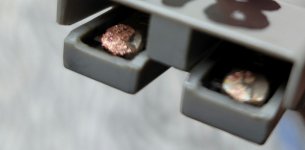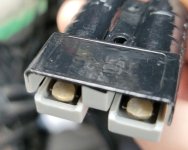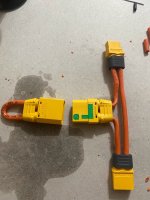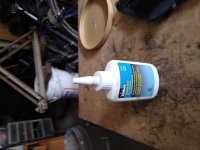Yes certainly.
A proper long lasting EV takes good consideration of its precharge system, for good measure and many reasons. There can be a impropper design, and a proper design, ....
So.
QS8 and QS10 are recommended for these installs all the time.. but.. they dont cut it. It is silly, I have burned out or eroded all the contacts with those premade 5.6 ohm resistances inside them.
H9owever, they are large current carrying connectors that can handle a good amount of load current when they are engaged properly.
A QS8, 10, or XT90-s are ALL 5.6 ohms precharge resistor of like 2w rating .. made to precharge rc hobby batteries on the esc... at 22v nomninal. Low voltage. Only.
You have 5 TIMES !! that.. .... " 22v". you need a MUCH slower precharge than a 5.6 ohm 2w would provide. RC has small caps and tiny esc made for 22.2v .. Lol... You have 120!!!!! v... a big controller... with some very big ( capacitance) capacitors... Especially with 200v caps ( that your 117v controller almost certainty has, ie big spark) .
Do the math. You can see how much faster a 6 ohm is compared to say.. A 100 ohm 10w resistor. Or use a 1000 Ohm 10 watt resistor. If you dont know the math i will lay it out for you . You want a circuit to keep the high current form hitting the controller and blowing up caps or sparking contacts.
1KOhm, 10watt. Good, slow precharge, not slamming the controller. Precharge takes 500 milliseconds.. current is limited, and the controller can do this 10,000 times without damage..
If you use a 5.6 ohm 2w.. you slam the controller with lots of current, erode contacts, and precharge in 10 milliseconds.. so t speak...
A QS8 or QS10 is a band aid and does not protect the controller well and is not good for a long life in a system.
Use Precharge relays. Thos big controller love to zap the 200v caps and that is a HUGE inrush of current.
If you dont want to wire a keyswitch to relays.. plus have a maintenance disconnect.. You are playing with " making sometihing work" as opposed to " a proper design... "
No real electric vehicle removes the battery at will. They are all bolted in and never disconnects physically from the car.. and the precharge is served by relays and keyswitches and fused circuitry.
Just run the battery current through a 1kohm 10w resistor to the controller right before you hook up main leads. I use a switched circuit for this. I hook up battery to a open system ( main switch open) .. engage precharge circuit... (10w1Kohm) .. wait a second.. and then throw the main switch contacts switchgear. This will completely get rid of the spark zap and give the controller a long healthy life with nothing getting hot.
Lets look at a correct.... 20w, 2000ohm precharge resistor ....vs the QS8 or QS10....
The math.
You are asking How much power will this 2K ohm 20watt take? When energized with a 117v circuit power source?
...under constant current conditions... at 117v... the 2000 ohm resistor conduct exactly 0.0585 amps current and will need to dissipate 6.84 watts (well within the 20w rating of the resistor)...
You will be fine with that. V=IR The 2K20w will only need to dissipate 6.8w of energy to be energized continuously. 6.8w on a 20w rated resistor is good continuous long lasting design, ie, reliable years down the line.
https://ohmslawcalculator.com/ohms-law-calculator
(Conversely.. Lets apply the same formula to a QS10... a QS10 of 5.6 ohms would need to dissipate 2444.46 watts and a current of 20A would travel through that resistance... and probably fry ( burn out?) the QS10 because it has a 2w resistor inside it.... and then you would be just " imagining" you are precharging.. because the user does not know any better but at least you got a cool black plug with a red line on it like all the cool kids) ...
If you dont have a " main disconnect switch"... and you " want to hook up the battery leads by hand.. " .. I will tell you automation is foolproof and this is why they dont do that in real electric cars.
(Human) Hands and voltage dont go together well.. ( see wiki on " electric chair") ... AND SO THERE FOR DESIGNERS TRY TO DESIGN WITH LITTLE "HUMAN " INTERACTION AS POSSIBLE WHEN THERE ARE ISOLATED SYSTEMS AT PLAY AND HIGH VOLTAGES ( THAT 120V CERTAINLY IS ) ... >>>>
So.. either you can be the " Switch" for the rest of you life ( dangerous) or you can buy a proper relay solenoid switch. I am not one to say which you will do, you will do what you want.. but.. be careful with 120v DC and a strong battery. I would rather keep all " hands" and " plugging in " out of the plan if I were you.
It is a concept of " idiotproofing"... The lesser human interaction, the less there is to go wrong.
Also to make not of.. ONCE the main contacts are connected.. ALL power stops flowing through the prechage circuits. All current stops through this part of the circuit ( the 6.8w, ) because it has a new, lower resistance path to follow.. ( the main leads)...
this is why some get away with a QS10... they plug it in fast.. to not burn out the resistor.. But this negates the precharge function of the s resistance..
.... but every now and again.. you see someone who was recommend the QS10 or XT90s or QS8.. and they plugged it in.. but not all the way.. and the next thing they know they have a burning, smoking mess on the lines cause the current is burning up the 5.6OHM 2W resistance of the QS8.... 20A and 2000w is just turning that thing to smoke, they panic, and rip the connectors apart. ..this is what happens if you mess up pluggin a 5.6 oHm QS10 into a circuit a little bit but not all the way.. Instant magic smoke.
You need the precharge female on the battery and the precharge male on the controller...
You think of the controller as a " basin of ducklings"... and the battery as a " lake of water"... You want to fill the basin slowly.. with a trickle ( first... ) .. with the precharge resistor... Then apply full battery voltage to the controller ( second)..
If you fill the basin with a 5 gallon bucket thown at the ducks ( 5.6oHm resistor, qs10?) the ducklings get mad.
If you fill the basin with a fire hose the ducklings get even madder ( and maybe even injured)... ( no precharge at all) .
The 20w2K resistor is a good " trickle". Will not hurt the duckies. Will fill the basin so that you can then they can get out to the lake and play.
Nothing wrong with a good manual precharge system. Just becomes a burden to remember every time but i do it that way. It will protect the controller well and keep your contacts from arc flashing.
120vDC is not something you want to play with to much by hand. Andersons have very good insulation and you will not have to touch anything hot. you could use a 20g wire for this, easily, it takes less than an amp when energized. That will fill the basin slowly, THEN connect the main contacts, and that is the good way to do it.
A spade terminal. A banana plug like from a multimeter. a small rc grade gold banana. it only needs to take 1 amp with a 2K resistance. Its half an amp of current and very low dissipate power.
Precharge does not take alot of " energy".. it only takes a finite, small, amount. To keep the shock wave of the battery connection fro filling the controller electronics and causing damage to fast. Once charged, the current drops to 0 in that line. However, a good precharge saves electronics form damage from " inrush current".






